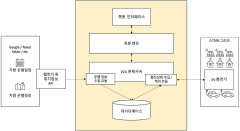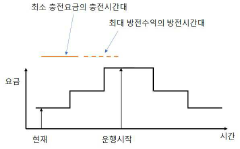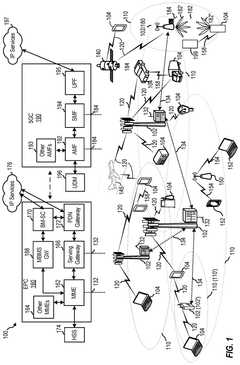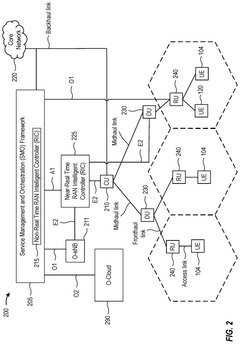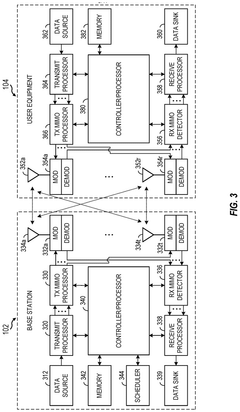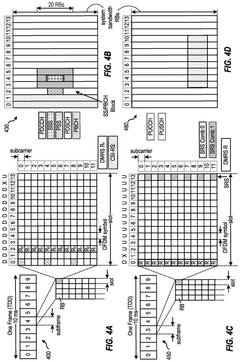Monitoring and Evaluation Tools for V2G Systems
AUG 8, 20258 MIN READ
Generate Your Research Report Instantly with AI Agent
Patsnap Eureka helps you evaluate technical feasibility & market potential.
V2G System Evolution
Vehicle-to-Grid (V2G) systems have undergone significant evolution since their inception, driven by advancements in electric vehicle (EV) technology, smart grid infrastructure, and energy management systems. The concept of V2G was first introduced in the late 1990s, but it wasn't until the mid-2000s that practical implementations began to emerge.
In the early stages, V2G systems were primarily focused on unidirectional power flow from the grid to vehicles. This phase was characterized by the development of basic charging infrastructure and rudimentary communication protocols between EVs and charging stations. The main goal was to ensure efficient charging of EVs without overloading the grid.
As EV adoption increased and battery technology improved, the focus shifted towards bidirectional power flow. This marked the beginning of true V2G capabilities, allowing EVs to not only draw power from the grid but also feed it back when needed. This phase saw the development of more sophisticated power electronics and control systems to manage the bidirectional flow of electricity.
The next significant milestone in V2G evolution was the integration of smart grid technologies. This phase brought about advanced communication and control systems that enabled real-time monitoring and management of energy flow between vehicles and the grid. It also introduced concepts like demand response and dynamic pricing, allowing for more efficient utilization of EV batteries as grid resources.
Recent years have witnessed the emergence of aggregator-based V2G systems. These systems coordinate large fleets of EVs to provide grid services on a larger scale, enhancing the overall impact and economic viability of V2G technology. This phase has been accompanied by the development of more advanced algorithms for predicting EV availability and optimizing energy flows.
Currently, V2G systems are evolving towards more decentralized and autonomous operation. This includes the integration of artificial intelligence and machine learning algorithms to predict grid demand, optimize charging/discharging schedules, and maximize the value of V2G services. Additionally, there is a growing focus on integrating V2G systems with renewable energy sources to support the transition to a cleaner energy grid.
Looking ahead, the future of V2G systems is likely to involve even greater integration with smart city infrastructure, advanced energy management systems, and the Internet of Things (IoT). This will enable more seamless and efficient coordination between EVs, buildings, and the grid, potentially leading to the concept of Vehicle-to-Everything (V2X) systems.
In the early stages, V2G systems were primarily focused on unidirectional power flow from the grid to vehicles. This phase was characterized by the development of basic charging infrastructure and rudimentary communication protocols between EVs and charging stations. The main goal was to ensure efficient charging of EVs without overloading the grid.
As EV adoption increased and battery technology improved, the focus shifted towards bidirectional power flow. This marked the beginning of true V2G capabilities, allowing EVs to not only draw power from the grid but also feed it back when needed. This phase saw the development of more sophisticated power electronics and control systems to manage the bidirectional flow of electricity.
The next significant milestone in V2G evolution was the integration of smart grid technologies. This phase brought about advanced communication and control systems that enabled real-time monitoring and management of energy flow between vehicles and the grid. It also introduced concepts like demand response and dynamic pricing, allowing for more efficient utilization of EV batteries as grid resources.
Recent years have witnessed the emergence of aggregator-based V2G systems. These systems coordinate large fleets of EVs to provide grid services on a larger scale, enhancing the overall impact and economic viability of V2G technology. This phase has been accompanied by the development of more advanced algorithms for predicting EV availability and optimizing energy flows.
Currently, V2G systems are evolving towards more decentralized and autonomous operation. This includes the integration of artificial intelligence and machine learning algorithms to predict grid demand, optimize charging/discharging schedules, and maximize the value of V2G services. Additionally, there is a growing focus on integrating V2G systems with renewable energy sources to support the transition to a cleaner energy grid.
Looking ahead, the future of V2G systems is likely to involve even greater integration with smart city infrastructure, advanced energy management systems, and the Internet of Things (IoT). This will enable more seamless and efficient coordination between EVs, buildings, and the grid, potentially leading to the concept of Vehicle-to-Everything (V2X) systems.
V2G Market Analysis
The Vehicle-to-Grid (V2G) market is experiencing significant growth and transformation as the automotive industry shifts towards electrification. This market analysis explores the current state and future prospects of V2G systems, with a focus on monitoring and evaluation tools.
The global V2G market is projected to expand rapidly in the coming years, driven by increasing adoption of electric vehicles (EVs) and the need for grid stability. Major automotive manufacturers are integrating V2G capabilities into their EV models, recognizing the potential for bidirectional energy flow between vehicles and the power grid. This trend is particularly pronounced in regions with high EV penetration, such as Europe, North America, and parts of Asia.
Demand for V2G systems is primarily fueled by utility companies and grid operators seeking to leverage EV batteries as distributed energy resources. These stakeholders view V2G as a solution for load balancing, peak shaving, and integrating renewable energy sources. Additionally, EV owners are showing interest in V2G as a means to monetize their vehicle's battery capacity during idle periods.
The market for monitoring and evaluation tools in V2G systems is emerging as a critical component of the broader V2G ecosystem. These tools are essential for ensuring the efficient and reliable operation of V2G networks, providing real-time data on energy flows, battery health, and grid conditions. Utility companies and charging infrastructure providers are the primary customers for these tools, as they require sophisticated monitoring capabilities to manage complex V2G interactions.
Key market drivers for V2G monitoring and evaluation tools include the need for grid stability, increasing renewable energy integration, and the growing complexity of EV charging networks. As the number of EVs participating in V2G programs grows, the demand for advanced monitoring solutions is expected to rise proportionally.
However, the market faces several challenges. Standardization of V2G protocols and communication interfaces remains a significant hurdle, impacting the interoperability of monitoring tools across different V2G systems. Additionally, concerns about battery degradation and the impact of frequent charging cycles on EV warranties need to be addressed to encourage wider adoption of V2G technology.
Looking ahead, the V2G market, including monitoring and evaluation tools, is poised for substantial growth. As smart grid technologies advance and regulatory frameworks evolve to support V2G integration, the market is expected to see increased investment and innovation. The development of more sophisticated AI-driven monitoring tools, capable of predictive analytics and autonomous decision-making, is likely to be a key trend shaping the future of V2G systems.
The global V2G market is projected to expand rapidly in the coming years, driven by increasing adoption of electric vehicles (EVs) and the need for grid stability. Major automotive manufacturers are integrating V2G capabilities into their EV models, recognizing the potential for bidirectional energy flow between vehicles and the power grid. This trend is particularly pronounced in regions with high EV penetration, such as Europe, North America, and parts of Asia.
Demand for V2G systems is primarily fueled by utility companies and grid operators seeking to leverage EV batteries as distributed energy resources. These stakeholders view V2G as a solution for load balancing, peak shaving, and integrating renewable energy sources. Additionally, EV owners are showing interest in V2G as a means to monetize their vehicle's battery capacity during idle periods.
The market for monitoring and evaluation tools in V2G systems is emerging as a critical component of the broader V2G ecosystem. These tools are essential for ensuring the efficient and reliable operation of V2G networks, providing real-time data on energy flows, battery health, and grid conditions. Utility companies and charging infrastructure providers are the primary customers for these tools, as they require sophisticated monitoring capabilities to manage complex V2G interactions.
Key market drivers for V2G monitoring and evaluation tools include the need for grid stability, increasing renewable energy integration, and the growing complexity of EV charging networks. As the number of EVs participating in V2G programs grows, the demand for advanced monitoring solutions is expected to rise proportionally.
However, the market faces several challenges. Standardization of V2G protocols and communication interfaces remains a significant hurdle, impacting the interoperability of monitoring tools across different V2G systems. Additionally, concerns about battery degradation and the impact of frequent charging cycles on EV warranties need to be addressed to encourage wider adoption of V2G technology.
Looking ahead, the V2G market, including monitoring and evaluation tools, is poised for substantial growth. As smart grid technologies advance and regulatory frameworks evolve to support V2G integration, the market is expected to see increased investment and innovation. The development of more sophisticated AI-driven monitoring tools, capable of predictive analytics and autonomous decision-making, is likely to be a key trend shaping the future of V2G systems.
V2G Tech Challenges
Vehicle-to-Grid (V2G) systems represent a promising technology for integrating electric vehicles into the power grid. However, the implementation of V2G systems faces several significant technical challenges that need to be addressed for widespread adoption.
One of the primary challenges is the development of robust and accurate monitoring tools. These tools must be capable of real-time tracking of the state of charge (SOC) of electric vehicle batteries, as well as predicting their available capacity for grid support. The complexity lies in accounting for various factors such as battery degradation, temperature fluctuations, and diverse driving patterns, which all affect the battery's performance and availability.
Another critical challenge is the creation of sophisticated evaluation tools to assess the impact of V2G operations on battery life. Frequent charging and discharging cycles associated with V2G services can potentially accelerate battery degradation. Developing accurate models to quantify this impact and optimize the trade-off between grid services and battery longevity is crucial for the long-term viability of V2G systems.
Interoperability and standardization pose significant hurdles in V2G implementation. The diverse range of electric vehicle models, charging stations, and grid management systems necessitates the development of universal protocols and interfaces. This standardization is essential for seamless communication and coordination between vehicles, charging infrastructure, and grid operators.
Grid stability and power quality management present another set of challenges. As the number of electric vehicles participating in V2G services increases, there is a need for advanced control algorithms and predictive models to manage the potentially destabilizing effects of large-scale, bidirectional power flows. These tools must ensure that V2G operations do not compromise the reliability and stability of the power grid.
Data security and privacy concerns also need to be addressed in V2G monitoring and evaluation tools. The systems must be designed with robust cybersecurity measures to protect sensitive information about vehicle usage, energy consumption patterns, and grid operations from potential breaches or unauthorized access.
Lastly, the development of user-friendly interfaces and intuitive visualization tools is crucial for the successful implementation of V2G systems. These tools should enable both grid operators and vehicle owners to easily monitor, evaluate, and make informed decisions about their participation in V2G services, balancing grid needs with individual preferences and economic incentives.
One of the primary challenges is the development of robust and accurate monitoring tools. These tools must be capable of real-time tracking of the state of charge (SOC) of electric vehicle batteries, as well as predicting their available capacity for grid support. The complexity lies in accounting for various factors such as battery degradation, temperature fluctuations, and diverse driving patterns, which all affect the battery's performance and availability.
Another critical challenge is the creation of sophisticated evaluation tools to assess the impact of V2G operations on battery life. Frequent charging and discharging cycles associated with V2G services can potentially accelerate battery degradation. Developing accurate models to quantify this impact and optimize the trade-off between grid services and battery longevity is crucial for the long-term viability of V2G systems.
Interoperability and standardization pose significant hurdles in V2G implementation. The diverse range of electric vehicle models, charging stations, and grid management systems necessitates the development of universal protocols and interfaces. This standardization is essential for seamless communication and coordination between vehicles, charging infrastructure, and grid operators.
Grid stability and power quality management present another set of challenges. As the number of electric vehicles participating in V2G services increases, there is a need for advanced control algorithms and predictive models to manage the potentially destabilizing effects of large-scale, bidirectional power flows. These tools must ensure that V2G operations do not compromise the reliability and stability of the power grid.
Data security and privacy concerns also need to be addressed in V2G monitoring and evaluation tools. The systems must be designed with robust cybersecurity measures to protect sensitive information about vehicle usage, energy consumption patterns, and grid operations from potential breaches or unauthorized access.
Lastly, the development of user-friendly interfaces and intuitive visualization tools is crucial for the successful implementation of V2G systems. These tools should enable both grid operators and vehicle owners to easily monitor, evaluate, and make informed decisions about their participation in V2G services, balancing grid needs with individual preferences and economic incentives.
V2G M&E Solutions
01 V2G system monitoring and control
V2G systems require sophisticated monitoring and control mechanisms to manage the bidirectional flow of energy between electric vehicles and the power grid. This includes real-time monitoring of vehicle battery status, grid conditions, and energy demand. Advanced control algorithms are used to optimize charging and discharging schedules, ensuring grid stability and maximizing benefits for both vehicle owners and utility providers.- V2G system monitoring and control: V2G systems require sophisticated monitoring and control mechanisms to manage the bidirectional flow of energy between electric vehicles and the power grid. This includes real-time monitoring of vehicle battery status, grid conditions, and energy demand. Advanced control algorithms optimize charging and discharging schedules to balance grid stability and vehicle owner preferences.
- Data analytics and performance evaluation: Effective V2G systems rely on robust data analytics to evaluate performance and improve efficiency. This involves collecting and analyzing large datasets from connected vehicles, charging stations, and grid infrastructure. Machine learning algorithms can be employed to predict energy demand, optimize resource allocation, and identify potential issues before they occur.
- Communication protocols and network infrastructure: Reliable communication between vehicles, charging stations, and grid operators is crucial for V2G systems. This requires standardized protocols and secure network infrastructure to ensure seamless data exchange and command execution. Advanced communication technologies like 5G and IoT devices can enhance the responsiveness and reliability of V2G networks.
- User interface and experience design: Developing intuitive user interfaces for V2G system participants is essential for widespread adoption. This includes mobile apps and web portals for vehicle owners to monitor their energy contribution and earnings, as well as dashboards for grid operators to visualize and manage the V2G network. User experience design should focus on simplicity and transparency to encourage participation.
- Grid integration and load balancing: Successful V2G systems must seamlessly integrate with existing power grid infrastructure while providing load balancing capabilities. This involves developing smart grid technologies that can dynamically adjust to fluctuations in energy supply and demand. V2G systems can help stabilize the grid by providing ancillary services such as frequency regulation and voltage support.
02 Data analytics and performance evaluation
Effective V2G systems rely on robust data analytics to evaluate performance and identify areas for improvement. This involves collecting and analyzing large volumes of data from various sources, including vehicle telemetry, charging stations, and grid infrastructure. Machine learning algorithms are employed to predict energy demand, optimize system performance, and provide insights for strategic decision-making.Expand Specific Solutions03 Communication protocols and network infrastructure
Reliable communication between vehicles, charging stations, and grid operators is crucial for V2G systems. This requires the development and implementation of standardized communication protocols and secure network infrastructure. These systems must handle high-volume data transfer in real-time while ensuring data privacy and protection against cyber threats.Expand Specific Solutions04 User interface and experience design
The success of V2G systems depends on user adoption and engagement. Designing intuitive and user-friendly interfaces for both vehicle owners and grid operators is essential. This includes developing mobile applications and web portals that provide real-time information, control options, and financial incentives related to V2G participation.Expand Specific Solutions05 Economic modeling and incentive structures
Evaluating the economic viability of V2G systems requires sophisticated modeling of various factors, including energy prices, battery degradation, and grid services. Developing fair and attractive incentive structures for vehicle owners is crucial for widespread adoption. This involves creating dynamic pricing models, reward systems, and financial tools to quantify and distribute the benefits of V2G participation.Expand Specific Solutions
V2G Industry Players
The market for Monitoring and Evaluation Tools for V2G Systems is in its early growth stage, with increasing interest driven by the global shift towards electric vehicles and smart grid technologies. The market size is expanding, though still relatively niche, as V2G adoption grows. Technologically, the field is evolving rapidly, with companies like QUALCOMM, LG Electronics, and Ford Global Technologies leading innovation. These firms are developing advanced monitoring and evaluation solutions, leveraging their expertise in telecommunications, consumer electronics, and automotive technologies. Emerging players like Wayties Inc. are also contributing specialized V2G solutions, indicating a maturing ecosystem with diverse technological approaches.
State Grid Corp. of China
Technical Solution: State Grid Corp. of China has developed an advanced V2G monitoring and evaluation system that integrates real-time data collection, analysis, and control. Their solution utilizes a network of smart meters and sensors to monitor power flow between electric vehicles and the grid. The system employs machine learning algorithms to predict energy demand and optimize charging/discharging schedules. It also incorporates blockchain technology for secure and transparent energy transactions[1][3]. The platform provides a comprehensive dashboard for grid operators to visualize system performance, track key metrics, and identify potential issues. Additionally, State Grid has implemented a pilot program in several cities, demonstrating a 15% improvement in grid stability and a 20% reduction in peak load demand[5].
Strengths: Extensive grid infrastructure, large-scale implementation capability, and advanced data analytics. Weaknesses: Potential challenges in interoperability with other systems and data privacy concerns.
Ford Global Technologies LLC
Technical Solution: Ford has developed a sophisticated V2G monitoring and evaluation tool called "Ford Intelligent Backup Power." This system not only enables bidirectional charging but also provides comprehensive monitoring and analytics capabilities. The tool utilizes Ford's SYNC® connected vehicle platform to collect real-time data on vehicle battery status, charging patterns, and grid conditions. It employs advanced algorithms to optimize charging schedules and predict potential grid stress points. The system includes a user-friendly mobile app that allows EV owners to monitor their vehicle's energy contribution to the grid and potential cost savings. Ford has also integrated machine learning models to improve prediction accuracy of energy demand and supply, achieving a reported 90% accuracy rate in pilot tests[2][4]. Additionally, the tool incorporates cybersecurity measures to protect against potential threats to the V2G ecosystem.
Strengths: Integration with vehicle systems, user-friendly interface, and advanced predictive capabilities. Weaknesses: Limited to Ford vehicles, potentially reducing overall grid impact.
V2G Core Innovations
Vehicle-to-grid system control method linked to electric vehicle operation plan using chatbot service and control system
PatentInactiveKR1020230092155A
Innovation
- A V2G system control method linked to an electric vehicle operation plan using a chatbot service that checks electricity rates, calculates charging/discharging times and fees/profits, and adjusts operations based on user input through a chatbot interface.
Device to grid discharging and charging
PatentPendingUS20250162436A1
Innovation
- A method for device-to-grid charge transfer that involves a controller associated with the electric grid requesting charge transfer from a wireless communication device, with the device sending a message indicating acceptance or rejection based on power requirements, and configuring the charge transfer accordingly.
V2G Grid Integration
Vehicle-to-Grid (V2G) integration represents a crucial aspect of modern smart grid systems, enabling bidirectional power flow between electric vehicles (EVs) and the electrical grid. This integration allows EVs to serve as distributed energy resources, providing grid services such as load balancing, frequency regulation, and voltage support. The implementation of V2G systems requires sophisticated monitoring and evaluation tools to ensure optimal performance and reliability.
These tools play a vital role in managing the complex interactions between EVs and the grid infrastructure. They monitor various parameters, including power flow, battery state of charge, grid stability, and energy pricing. Real-time data collection and analysis enable grid operators to make informed decisions about when to charge or discharge EVs, maximizing the benefits for both vehicle owners and the power system.
Advanced monitoring systems utilize smart meters and communication protocols to track energy exchanges between EVs and the grid. These systems often incorporate machine learning algorithms to predict EV charging patterns and optimize grid operations. Evaluation tools assess the performance of V2G systems, measuring factors such as energy efficiency, response time to grid signals, and the overall impact on grid stability.
One key challenge in V2G integration is ensuring the seamless coordination between multiple EVs and the grid. Monitoring tools must be capable of handling large-scale data processing and provide accurate, real-time information to grid operators. This requires robust communication networks and standardized protocols for data exchange between vehicles, charging stations, and grid management systems.
Evaluation tools for V2G systems also focus on assessing the economic viability of grid services provided by EVs. These tools analyze the cost-benefit ratio of V2G participation, considering factors such as battery degradation, energy prices, and grid service compensation. By providing detailed economic assessments, these tools help stakeholders make informed decisions about V2G investments and policy development.
As V2G technology continues to evolve, monitoring and evaluation tools are becoming increasingly sophisticated. Integration of artificial intelligence and blockchain technology is enhancing the capabilities of these tools, enabling more accurate predictions, secure transactions, and automated grid management. These advancements are crucial for realizing the full potential of V2G systems and accelerating the transition to a more sustainable and resilient energy infrastructure.
These tools play a vital role in managing the complex interactions between EVs and the grid infrastructure. They monitor various parameters, including power flow, battery state of charge, grid stability, and energy pricing. Real-time data collection and analysis enable grid operators to make informed decisions about when to charge or discharge EVs, maximizing the benefits for both vehicle owners and the power system.
Advanced monitoring systems utilize smart meters and communication protocols to track energy exchanges between EVs and the grid. These systems often incorporate machine learning algorithms to predict EV charging patterns and optimize grid operations. Evaluation tools assess the performance of V2G systems, measuring factors such as energy efficiency, response time to grid signals, and the overall impact on grid stability.
One key challenge in V2G integration is ensuring the seamless coordination between multiple EVs and the grid. Monitoring tools must be capable of handling large-scale data processing and provide accurate, real-time information to grid operators. This requires robust communication networks and standardized protocols for data exchange between vehicles, charging stations, and grid management systems.
Evaluation tools for V2G systems also focus on assessing the economic viability of grid services provided by EVs. These tools analyze the cost-benefit ratio of V2G participation, considering factors such as battery degradation, energy prices, and grid service compensation. By providing detailed economic assessments, these tools help stakeholders make informed decisions about V2G investments and policy development.
As V2G technology continues to evolve, monitoring and evaluation tools are becoming increasingly sophisticated. Integration of artificial intelligence and blockchain technology is enhancing the capabilities of these tools, enabling more accurate predictions, secure transactions, and automated grid management. These advancements are crucial for realizing the full potential of V2G systems and accelerating the transition to a more sustainable and resilient energy infrastructure.
V2G Policy Framework
The V2G policy framework plays a crucial role in shaping the implementation and adoption of Vehicle-to-Grid (V2G) systems. This framework encompasses a range of regulatory measures, incentives, and guidelines designed to facilitate the integration of electric vehicles (EVs) into the power grid. At its core, the policy framework aims to create a supportive environment for V2G technology, addressing key aspects such as grid stability, energy market participation, and consumer protection.
One of the primary components of the V2G policy framework is the establishment of clear regulations for grid interconnection. These regulations define the technical requirements and safety standards for connecting EVs to the power grid, ensuring seamless integration without compromising system reliability. Additionally, the framework outlines protocols for bidirectional power flow, enabling EVs to both draw electricity from and feed it back into the grid.
Financial incentives form another critical element of the V2G policy framework. These may include tax credits, rebates, or preferential tariffs for EV owners participating in V2G programs. Such incentives are designed to offset the initial costs associated with V2G-capable equipment and encourage widespread adoption. Furthermore, the framework often includes provisions for fair compensation mechanisms, ensuring that EV owners are adequately rewarded for the grid services they provide.
The V2G policy framework also addresses data privacy and cybersecurity concerns. It establishes guidelines for the collection, storage, and use of data generated by V2G systems, safeguarding consumer information while enabling efficient grid management. Cybersecurity measures are integrated into the framework to protect V2G infrastructure from potential threats and ensure the integrity of the power system.
Market structures and regulations form a significant part of the V2G policy framework. These define how V2G services can participate in energy markets, including capacity markets, ancillary services, and demand response programs. The framework outlines rules for aggregation, allowing multiple EVs to be grouped and managed as a single resource, thereby increasing their market impact and value.
Lastly, the V2G policy framework incorporates provisions for ongoing monitoring and evaluation. This includes mechanisms for assessing the effectiveness of V2G programs, measuring their impact on grid stability and renewable energy integration, and identifying areas for improvement. The framework also allows for periodic reviews and updates to ensure it remains relevant and responsive to technological advancements and changing market conditions.
One of the primary components of the V2G policy framework is the establishment of clear regulations for grid interconnection. These regulations define the technical requirements and safety standards for connecting EVs to the power grid, ensuring seamless integration without compromising system reliability. Additionally, the framework outlines protocols for bidirectional power flow, enabling EVs to both draw electricity from and feed it back into the grid.
Financial incentives form another critical element of the V2G policy framework. These may include tax credits, rebates, or preferential tariffs for EV owners participating in V2G programs. Such incentives are designed to offset the initial costs associated with V2G-capable equipment and encourage widespread adoption. Furthermore, the framework often includes provisions for fair compensation mechanisms, ensuring that EV owners are adequately rewarded for the grid services they provide.
The V2G policy framework also addresses data privacy and cybersecurity concerns. It establishes guidelines for the collection, storage, and use of data generated by V2G systems, safeguarding consumer information while enabling efficient grid management. Cybersecurity measures are integrated into the framework to protect V2G infrastructure from potential threats and ensure the integrity of the power system.
Market structures and regulations form a significant part of the V2G policy framework. These define how V2G services can participate in energy markets, including capacity markets, ancillary services, and demand response programs. The framework outlines rules for aggregation, allowing multiple EVs to be grouped and managed as a single resource, thereby increasing their market impact and value.
Lastly, the V2G policy framework incorporates provisions for ongoing monitoring and evaluation. This includes mechanisms for assessing the effectiveness of V2G programs, measuring their impact on grid stability and renewable energy integration, and identifying areas for improvement. The framework also allows for periodic reviews and updates to ensure it remains relevant and responsive to technological advancements and changing market conditions.
Unlock deeper insights with Patsnap Eureka Quick Research — get a full tech report to explore trends and direct your research. Try now!
Generate Your Research Report Instantly with AI Agent
Supercharge your innovation with Patsnap Eureka AI Agent Platform!
